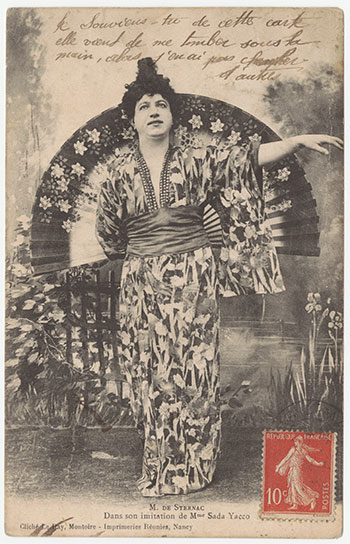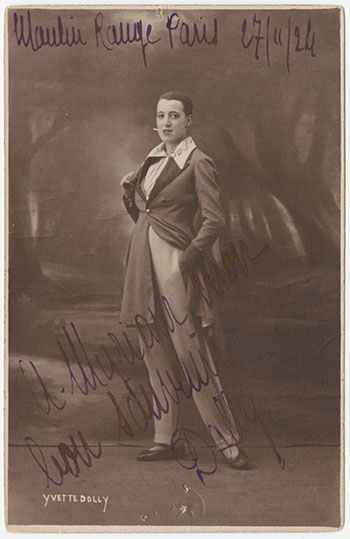Cornell University Library Digital Collections
Postcards of female and male impersonators and cross-dressing in Europe and the United States, 1900-1930
This collection of Postcards of female and male impersonators and cross-dressing in Europe and the United States, 1900-1931, 1955 features copies of original postcards held by Cornell’s Human Sexuality Collection, part of Cornell Library’s Division of Rare and Manuscript Collections. They reflect the complete contents of two collections as of June 2019: Postcards of female and male impersonators and cross-dressing, #7778 and Postcards of German female impersonators, #7636. Digitization and description of these physical materials were was supported by the Grants Program for Digital Collections in Arts and Sciences, awarded to Durba Ghosh, Professor in the Department of History and Feminist, Gender, and Sexuality Studies Program at Cornell University, in 2018. Collaborators on the this project included: Leslie Adelson, German; Mitchell Greenberg, Romance Studies; Tamara Loos, History; Brenda Marston, Cornell University Library; and Kristin Roebuck, History.
The following introduction to the collection was written by Durba Ghosh and Brenda Marston.
Postcards first appeared in the middle of the 1800s, with the expansion of the postal system in many countries and the ability to mass produce printed images. By the latter part of the century, postcards in the way we know them now emerged as a common way for people to communicate by writing: conventionally, the postcard has an image on the front, with the message and address to a recipient on the back. Their popularity grew as the travel and tourist industry expanded; the postcard also became central to advertisers who wanted to make their products visible. Collecting historical or vintage postcards is now a popular hobby; by some accounts, postcard collecting or deltiology ranks third behind coin and stamp collecting.
These selected postcards from multiple collectors show how widespread cabaret and stage performances by male and female impersonators were in early 20th century Europe and North America. The terms for these gender expressions used on the cards include the German “Damen-Imitator” and the French “travesti » and « travesti-dame. » The photographs on their fronts feature both cis-gendered men in women’s clothes and bodily poses and cis-gendered women in conventionally masculine clothing and comportment. In these postcards, a range of bodies portray musicians, dancers, actors, soldiers, sailors, aristocrats, historical figures, working men and women, and romantic couples, often with one portraying traditional and one portraying nontraditional gender expression. Even though 21st c. feminist and queer scholars think of gender as performance (rather than biologically determined), the act of cross-dressing or transvestitism was a subversive act at the turn of the twentieth century when the majority of these cards were produced. The question marks displayed on some cards, such as “? Asta ?,” “? Hardi Simon ?,” and “? Luzernow ?,” serve to consciously question gender fixity. The subjects of these images challenged gender norms and binaries, even as they mark a historical moment in which gender impersonation appeared a common postcard genre. The images may document what these subjects aspired to be or the varied gender expressions their audiences yearned to see. Two outstanding postcards show actress Jeanne Bloch convincingly portraying the then president of the French Republic, Armand Fallières, and at a time when French women did not yet have even the right to vote.
Notably, unlike many postcards of this period, they do not showcase monuments or architectural marvels; they do not depict street scenes or spectacular natural landscapes. Unlike many postcards intended for public consumption, these postcards display an intimacy between photographer and subject. Most of these images are not taken in public; when they are outside, they are in a garden, rather than on the street. The photographs were often taken (and likely viewed) in intimate and private spaces. Some of the cards have messages on the back and postmarks showing they were mailed. For research purposes, we have digitized both sides of all 442 cards. In viewing any card, the reverse side is easily available under “additional views.” The image ID number gives the collection, box, folder, and item number along with “01” for the recto and “02” for the verso.
This collection can be searched by the country of origin (in alphabetical order): Austria, Belgium, France, Germany, Italy, Romania, Spain, Sweden, United Kingdom, and the United States. We have determined that one of the French postcards portrays an African American act from Harlem that travelled to perform at Paris’ upscale circus, Nouveau Cirque. One German postcard features “Gauze, Canadian Indian soprano.”
Although many of the postcards can be viewed individually, there are series, sets, or what are called photo narratives in which a group of viewed together tell a story. There are numerous seduction scenes, such as the 10 French cards in the series “Les Cerises [Cherries]” in which a male impersonator climbs a ladder to pick cherries, offers them to a female, and leans in to kiss her on the cheek. We encourage you to take a look at the series titled “Egg.” Many of the postcards feature photographs of theatrical or public performance such as musical hall or cabaret; some emphasize costumes, particularly historical costumes of figures from previous centuries troop; and a smaller number come from military shows, which include performances at prisoner of war camps. We have also tried to draw attention to the complicated practice of racial impersonation – for instance, take a look at the image of Minouche.
Dating between 1900 and 1931, with one postcard from 1955, the images play with depictions of race, colonialism, desire, and questions related to LGBT history. The collection supports research and teaching for gender and sexuality studies, performance studies, language and literature.
Further Sources
In the Human Sexuality Collection you will find a vast amount of other images and documents about the historical practices of cross-dressing, drag, transvestism, transsexuality, passing, and individual and collective efforts to create room for nontraditional gender and sexual expressions. Some of these artifacts, notably many of drag photographs from the Harry Weintraub collection, are already available as well in Cornell’s Digital Collections.
Examine the Originals
The original postcards portrayed in this digital collection can be consulted at Cornell in the Division of Rare and Manuscript Collections located in the Carl A. Kroch Library. Inquires about these and other original documents may be sent to rareref@cornell.edu.
Further Reading
- Short essays on the history of the postcard:
- A Postcard History (Smithsonian)
- The History of Postcards (Art History Archive)
- Naomi Schor, “‘Cartes Postales’: representing Paris 1900,” Critical Inquiry 18.2 (1992): 188-214.
- Malek Alloula, Colonial Harem (Minneapolis: University of Minnesota Press, 1986). See also, https://www.newyorker.com/books/second-read/colonial-postcards-and-women-as-props-for-war-making.
- Louis Lumière (camera), Le cake-walk au nouveau cirque. Film of the show "Joyeux Nègres" in Paris, 1902. The performer dressed as a man is Charles Gregory. http://art-des-muses.blogspot.com/2013/04/le-cake-walk-au-nouveau-cirque.html



